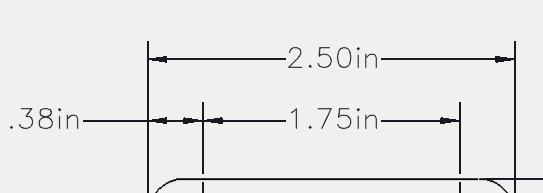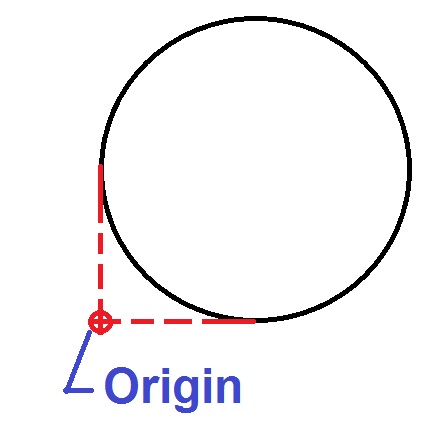Search the Community
Showing results for tags 'dimension'.
-
Create field from attribute in block and put it directly into dimension.
fromMlm posted a topic in AutoLISP, Visual LISP & DCL
Hi all, Again I have found a lisp Lee Mac made that copies a field into a dimension, "copyfield", but it requires that the field already exists... So is there a way to create a field from an attribute in a block and then insert the field directly into a dimension? Thanks in advance. -

How to show inch marks ( double quote ) after a decimal dimension?
ILoveMadoka posted a topic in SolidWorks
Solidworks 2023 How can I show inch marks after a decimal dimension? these are "hand-jammed" The closest I could figure out without having to manually change every dimension gave me this Is this possibl... -
How to get dimension Start point & End point of arrow head
Pugazh posted a topic in AutoLISP, Visual LISP & DCL
hello dears, I want to make line in multiple dimension using start point & end point of dimension. (defun c:makeline ( ) (setq ss (ssget "_:L" '((0 . "DIMENSION")))) (repeat (setq i (sslength ss)) (setq ent (ssname ss (setq i (1- i)))) (command "_.line" "_non" (cdr (as... -

Dimension’s extend line is overlap with others
haisagiviz posted a topic in AutoLISP, Visual LISP & DCL
Hi everyone, My question: Is there anyway to detect dimension's node when node’s distance from dimension line are greater than a number and move them back to dimension base line. My problem: the dimension's extend line is overlap with other line such as grid line, wall line and oth... -
Aligned Dimensions from a line to a perpendicular line, with centered text.
Jean-Lévy Plante posted a topic in AutoLISP, Visual LISP & DCL
I would like to modify this lisp script so that the dimension has a centered text instead of on a side of the dimension. But i don't know how. (defun c:HD (/ HD_LineHouse HD_LineProperty HD_Point1 HD_BasePoint1 HD_Text1 HD_Point2 HD_BasePoint2 HD_Text2 HD_ActiveDoc HD_ActiveSpace) (if... -
I thought it would be interesting to get a thread going about your favorite lisp. As I've been frequenting this forum, my list of lisps is ever-growing. I have some I think are excellent for what I do (steel detailer) but I wonder what is your favorite lisp? Maybe post here with a brief description...
-
Hi All, I have an issue about dimension scaling and any tips on how to make them even in paper space so it looks clean and symmetrical for architects to read. There are some drawings i use in MVIEW that are so large that the dimension texts are small. And some that are small that are easily...
-
Hello All, I am working on making Bills of Materials with Block information. I use tubing as a main component in my data extractions. What I would like to do is be able to extract the text overwritten length that I dictate from the all dimension leaders with the same part number, and add them to...
- 3 replies
-
- dimension
- data extraction
-
(and 1 more)
Tagged with:
-
LISP - Automatic dimensions according to set rules
Kyler posted a topic in AutoLISP, Visual LISP & DCL
Hello everyone, I work with a glazing company and am trying to write an AutoLISP command that will automate a large part of our job by dimensioning glass panels with holes and cutout in the format that our supplier prefers. I will attach a photo here to show what I have done so far. Th... -
Hello all, I wondered if it's possible to have a kind of command or lisp that gets the continue and baseline command in one single command? In the picture below you see the result I need in one command. Now it is done in 2 commands and it's taking a lot of time. Can somebody hel...
-
Hello, Could anyone help me let this LISP work. The lisp should go to the layer you choose (by pressing 1 or 2) when in a *DIM* command. After placing the dimension the layer should go back to the layer it was before selecting a *DIM* command. This is the code now. ; AFKORTINGEN V...
-
LISP script to perform Ordinate Dimension verification
Matt_D posted a topic in AutoLISP, Visual LISP & DCL
Hi All. This is my second attempt to post this since somehow I was logged out automatically. Thankfully I had most of this saved via a notepad file. Now down to business: I'm good with CAD, but when it comes to LISP, i'm a complete beginner. My boss/manager has asked me to create a LISP ro... -
Couldn't find it in solidworks 2015, the guy is using an old version of solidworks in the book i'm reading from, searched google to find out that that option has been removed since SW2010 SP2.1 Why would they do that ? Is there any alternative or any other option that does something similar ?...
-
Hello, I have made some object addon on a large outdoor festival plan made years ago. When I mesure some object I add, the mesure shown are'nt good. If a make a new object with the same dimension and I move it over the old one, the scale is match. I to fix those different scaling? Thank...
-
I need to set my origin a little different than inventor does it normaly. I have a circular plate and i want my origin on the intersection of tangents (low left corner) how do I do that.
-
Hi all, I am trying to get the dimension of the AFF tag to automatically populate with the movement of the dynamic block. As it stands, I cannot get the "AFF" dynamic dimension through an attribute definition. I tried following Ellen's tutorial (here) but no luck. Help is much appreciated....
-

Dimensions showing BOTH metric and imperial?
Sbeth85 posted a topic in AutoCAD 2D Drafting, Object Properties & Interface
Hi- I'd like to dimension a drawing in both feet and centimeters. Is there some sort of DimStyle workaround to get this to happen automatically? Yes, I know I could manually overwrite each dimension and do "inches", but is there a way to do it automatically? Thanks! -
dimension value fixing problem in simple lisp
anandhan posted a topic in AutoLISP, Visual LISP & DCL
(defun c:test () (setq obj (entsel "please select the dimension:-")) (setq ab (fix(getreal "please enter the value to change:-" ))) (command "dim1" "new" ab obj "") (princ) ) hi friends if i try to fix value more than 32600 it will fixed automatically some other value please... -
dimension grip node stuck at arrow tip
rhgrafix posted a topic in AutoCAD 2D Drafting, Object Properties & Interface
I searched the universe and can't find this answer, Sometimes I find an existing dimension where one end has the node that has been collapsed to the tip of the arrow, I can't figure out how to pull it back off the arrow tip. I use 2011, any ideas? Thanks! R.L. Hamm -
I work in the HVAC field. I've just around a year of experience with the program and have never had this problem before. I use 2 layers; 1 for piping and another for linears and dimensions, etc. For some reason, everything shows up on the model space, but once i plotted on the paper space, a good ch...
-

Programming on associative and nonassociative dimensions
Ahankhah posted a topic in AutoLISP, Visual LISP & DCL
Hi CADmates, I have drawings full of dimensions overlapping on each other. Should any one let me know how to get rid of this position via programming? I tried some coding to move text of dimensions, but no success on associative dimensions. ;| (MT:Move:DimensionText<-Ename (car (ents... -
Very slow properties CAD on a decent machine
ColinPearson posted a topic in AutoCAD 2D Drafting, Object Properties & Interface
Hi all, I would appreciate any help I could get on this matter. I'm running CAD2011, a pretty good flavor of an i5, 8GB, Win7x64, 1GB graphics, etc... a nice-enough laptop for sure that CAD should be run seamlessly. HOWEVER! When I select a dimension, it takes at least 5 seconds for the pro...- 20 replies
-
- properties
- fonts
-
(and 2 more)
Tagged with:
-
Inventor 2014 Dimensions, what is it called? and where can i change it at?
Sengna posted a topic in Autodesk Inventor
I want to change my dimension arrows to something like below, what is it called? and where can i change it at? screenshot if possible please, thanks -
We have set dimension styles and viewport scales in the office for standards, but some drawings don't have all of them loaded, same thing with the plot scales. What kind of file is it (dwt, lsp?) and how do I import it so they all are options to pick for all drawings so I don't have to make them man...
-
Continuous Running Dimensions, is it possible?
e_anders3 posted a topic in AutoCAD 2D Drafting, Object Properties & Interface
Is there a way to create a continuous dimension line that uses running dimensions instead individual segments? I know that you can do baseline measurement but I received a request to have the dimensions look like a continuous dimension line, but be running dimensions. I'm aware of UCS -> c...- 3 replies
-
- dimension style
- dimension lines
-
(and 2 more)
Tagged with:










